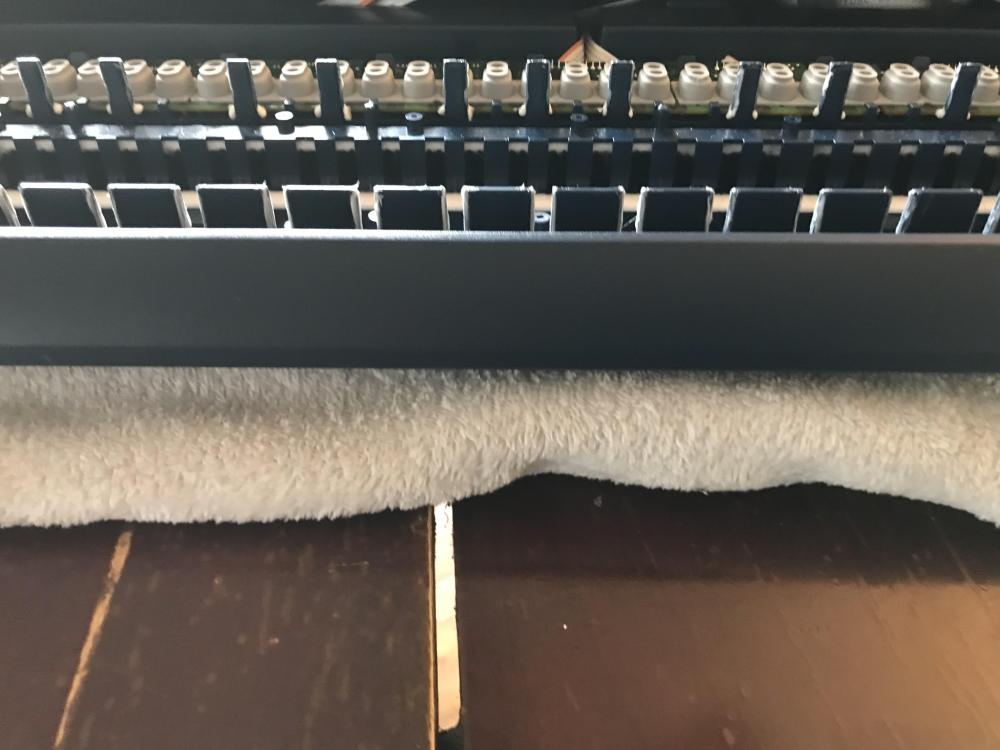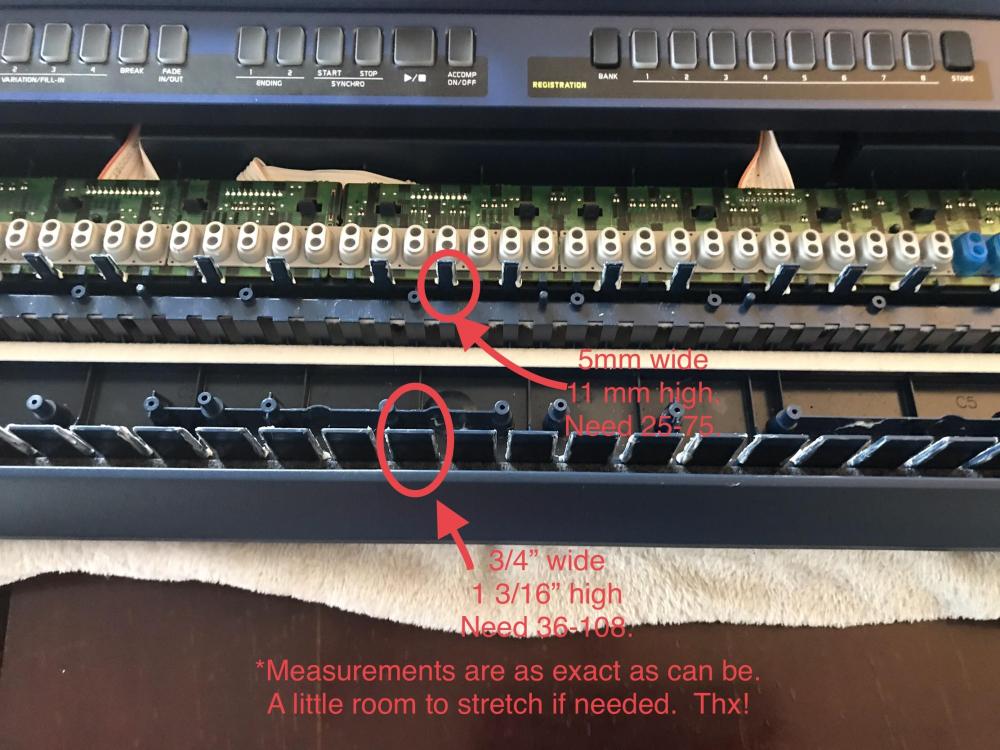
PeteT
Members-
Posts
32 -
Joined
-
Last visited
Content Type
Profiles
Forums
Downloads
Everything posted by PeteT
-
woodman, This links you to a video which teaches you how to build a pattern/rhythm. It’s not created on an MZX-500, but the principles are the same. I hope this helps.🙌🏾 PeteT Pete
-
Hey everyone, I don’t know what got into me, but I redid the keys and lubricated everything following the advice of Popsel. My only deviations from his advice were that I left the maple veneer in place underneath the tops of the keys to give them a bit more rigidity. I also left the white felt in place on the sides of the underside of the keys. I used two layers of felt to cushion and absorb the noise from the key stops. Both the underside and topside foam strips, (inside and outside the housing), were done. The keybed is firmer, more quiet, and worlds better than before. Casio should have spent $25 more on production materials. But, it’s better now. I’ll attempt to attached a video so as to show how it sounds. I’m a horrible keyboard player, so excuse the sounds emanating from the keyboard.🥲😆 IMG_3400.MOV
-
Popsel, I agree with Jokeyman. Thank you for spending so much time and effort to upload this video to YouTube. I lined the insides of the white keys with self-adhesive white felt and this reduced the noise tremendously. But then I took it out and I’m going to lubricate them the way that you do. I bought some Yamaha key grease and your video helps me to see where I should put that grease. The bottoms of the keys, (which come into contact with the top of the supports between each of the white keys where the fingers normally hit), I lined those with self-adhesive maple veneer to strengthen the key and soften the blow of the key against the top of the support. The felt would’ve worked inside the keys except for the fact that the keys didn’t move as freely as they should. If I had gotten a less dense and thinner felt it probably would’ve worked. Thanks again Popsel! Pete
-
Hey everyone! Could someone please comment on how and where to lube the keys in general? Thx! Pete
-
@Jokeyman123what you described will work as long as the shrink wrap responds as does other wrap I’ve used. I hadn’t thought about this solution nor about Harbor Freight. The idea is brilliant!!! The guys and gals on this forum make learning to play keys again all the more enjoyable! Thanks to everyone! Pete
-
@Jokeyman123I’m in construction by trade and am going past Harbor Freight tomorrow. I may stop in. So would you recommend, if I decide to do this, I also lubricate the insulating shrink wrap from Harbor Freight? Is the shrink wrap tubing reasonably slick? I bought some Yamaha key grease online. It’s far better than the lube Casio applied to this keyboard. Thanks again, @Jokeyman123
-
Jokeyman, I didn’t get the PTFE tabs because the manufacturer was unwilling to make only a few hundred. They required the purchase be into the thousands. I understand why, but I can’t imagine ever using so many. So if you look at my previous post I explain what I did. Jokeyman, the rubber tabs were to fit on both sides of the plastic tabs/key supports. So you think the ones from Harbor Freight might work for this? I was going to re-grease the insides of the keyset subassemblies, but at some point in the future I’d have to disassemble the keyboard and relubricate it. I’d like to avoid doing this ever again, if possible. I’ve spent more time repairing this keyboard than I have playing it. I became so frustrated with it, and to be honest I needed a digital piano, that I bought a Yamaha DGX 670. It’s great! But, this thing could be too! Thanks Jokeyman! Pete
-
@drb32856 I’ve been somewhat successful. I couldn’t get the manufacturer here in town to make up a few hundred PTFE sleeves, (I was gonna share them with users here), in both sizes needed to cover the support ”pillars” located between both the natural and accidental keys. So I decided to try a number of different ways to insulate the intersecting plastic parts. What I finally did was these few things: 1. I bought white self adhesive felt cut and attached it to the inside of each key on the closed end. This somewhat effectively insulates the keys from the keybed supports beneath every key. Note: I haven’t done this to the accidentals, (black keys), simply because the space beneath the keys is really narrow. It’s possible to do the accidentals. I haven’t the patience for this, tbh. Also, the black keys aren’t the problem. It’s the white, (natural), keys. 2. I attached self adhesive maple veneer to the underside of each natural key. This is Kris Nicholl’s suggestion according to the video posted on this forum. It works to both strengthen the plastic key sets and to soften the blow of the key(s) against the key support(s). Kris applied the wood veneer to more areas of the keyset subassemblies. I may do this since the board is still apart. 3. I have also attached more insulation to the rows of existing foam insulation underneath and below the keysets. I bought felt from the local craft/sewing store, got a roll of double sided adhesive tape, cut the tape to length, attached it to the wrong side of the felt, (matte finish side), and then cut the diy self adhesive tape/felt combo to length and width for each row of existing foam insulation. Lastly, I secured the felt directly on top of the existing styrofoam insulation. This has made a tremendous difference, especially to the row of sound deadening insulation underneath the keyboard case. This is the area where the key returns to resting after being released by the player. The plastic appendage shaped like a hook 🪝clacked as it returns to rest. Now it doesn’t. At the outset I said I’ve been somewhat successful because I haven’t finished. I need to know where to lubricate the keys and how much key grease should be applied there. Can anyone help? Please note: I’ll answer any questions you have that I have answers to. Also, please join in if you’d like to help make this amazing board play as quietly as it can. 🤦🏾♂️ RANT: i’ve spent about $100* on materials needed to make the adjustments that I’ve made so far. Casio likely could’ve spent 50 bucks more on each keyboard to do what I’ve done. Had they insulated the underside of each key with a sound deadening insulation we wouldn’t be here. Had they used more effective sound deadening insulation in the areas where the inferior insulation is applied, again we wouldn’t be here. So, for lack of insulation and/or better insulation, they’ve wasted money repairing and replacing unsatisfactory MZX 500’s. This thing is packed with so many features it’s mind-boggling. Shift some of the money spent in R&D to better insulation alone and this board likely would’ve been legendary. I just don’t understand it… *Clarification: I have spent about $65. Some of the supplies I bought I’ll use in the sewing that I do; so I can’t attribute the extra $35 to this project. I bought those things for this project, but don’t need them. This may mean that Casio likely would’ve spent $35 or less if the one to one ratio as applied by me here were to hold true. It likely would hold true because they wouldn’t have paid retail. Pete
-
After a long time not playing it, I wanted to share this regarding the keys on my MZX-500. I’ve located a place here in town that manufactures rubber, plastic, silicone, even PTFE caps, plugs, grommets, etc. These caps can be bought in standard or custom sizes. I’m hopeful that they have something that will work for me. Tbh, because of the problems that the keys have given me, (almost from the start), I haven’t played it much in the 2 years I’ve owned it. In fact, I recently bought a Yamaha DGX-670 that I love. I still want to solve the problem of the Casio’s noisy keys. I’ve included two pics I sent to the company that reveals what I plan to do. If it works, I’ll let you know. I’ve also bought and will install better foam strips between where the keys bottom out adjacent to the chassis/case. Maybe the foam and the rectangular caps can be a viable option for others to quiet their keyboard’s keys. Pics:
-
Searching for Information on Casio PRO-300
PeteT replied to brenan's topic in Classic Casio Discussion
@pianokeyjoe What do you do? I repaired the plastic housing on a PSR 8000, installed a pitch bend wheel, etc so I can probably figure it out with both some guidance. The MZX is a killer board with loads of tech and features built in, but Casio went cheap in places where it was imperative that they install quality material: key felt, subtly textured keys, buttons with good tactile feel, etc. I recently revisited this board and played with a few of the samples I purchased from a member of the forum. One in particular, Distorted Stack (electric guitar) is fantastic! I played the power chords from Green Day’s “Brain Stew” and it sounded amazing!!!🔥💪🏾🎸 Bravo to Silvano da Silva!!! I think I’m going to donate the Pro 200 to my local musical repair shop and cut my losses. Thanks for your input Pianoguy and pianokeyjoe! Pete- 23 replies
-
Searching for Information on Casio PRO-300
PeteT replied to brenan's topic in Classic Casio Discussion
Pianokeyjoe, Thanks for sharing that information. I still have the board. I’ve gotten a bit dismayed with my Casio boards because of issues with keybed noise on a 9 month old MZX-500. But I do appreciate the insight you’ve shared. I may explore the board again and see if there’s anything there as you describe. The first time I couldn’t see anything brown, blown nor was there any acidic residue. I contacted a Casio repair facility in town and they were less than enthusiastic about taking it in and searching for parts so that never went anywhere. I want to see it used again but who knows 🤷🏾♂️...- 23 replies
-
Searching for Information on Casio PRO-300
PeteT replied to brenan's topic in Classic Casio Discussion
Hi Lily! I’m Pete. 👋🏾. I am interested if it’s still available. Thanks for your kindness. Pete- 23 replies
-
vbdx66, I understand. One month is crazy! The good thing you have is a longer warranty scheme. Here in the States the warranty lasts 1 year. But if they use the same kind of inferior felt, plastic lubricants and the keys are a poor design, it probably doesn’t matter. I was going to buy a high quality, appropriate sized piano key felt and have the repair shop use that instead, but they say that it has to be replaced with Casio supplied felt or the warranty is voided. It’s nonsensical. C5-G5 and C6-G6 are the noisiest keys on my machine. I’m sorry your having problems with your keyboard. My heart really goes out to those of you who are primarily pianists/keyboardists. I’m not. I play alto sax, but want to continue to learn to play keys. I bought this because of all the great features: synthesis, arranger, pad functions, sampling, etc. But even a novice is discouraged from playing a noisy board.🤷🏾♂️😢 vbdx66, I hope yours gets repaired well.
-
Count me among those whose MZ-X500 has clickety-clackety-keys after 7 months of ownership and only about 20-40 hours of cumulative play time. It’s going to the repair shop, (local, only 15 minutes away from my home).
-
Cannot open Data Manager 6.1 on Catalina
PeteT replied to musicgeek's topic in WK-7500/7600 - CTK-7000/7200
Try this: https://support.apple.com/en-us/HT201468 -
Thx guys for indulging my inquiries. When in doubt read the manual! (My only defense is that a manual for an alto sax is barely 5 pages long and written infinitely more clearly🤦🏾♂️😂.) On page A1 of the tutorial manual, it has a diagram of the 3 ports X 16 channels per port. Port C (all 16 channels) is set aside for midi recorder playback. So just tapping either port button does it. There don’t seem to be any program change restrictions either. It appears even user tones can be used in place of the GM instrumentation, (I 🤔, haven’t tried yet). Thanks again everyone. Now my backing tracks can be updated, even on the fly I can audition sounds. Man, if this thing had 88 fully weighted wooden keys it would be near perfect!
-
Thx Jokeyman! So in essence these program change messages have to be set to what I’d like before playing the file. It’d be nice if there was an open program change function built into these files for instrument experimentation on the keyboard. I’ve got a PSR 730 that has a revoice function on the front panel. Only thing is it doesn’t work for smf’s just styles. I’ll experiment with event editing or do it via the DAW. Thx again guys!
-
I hope so. I love the raw power of this board. Thx Brad. Pete
-
Thx Brad. On the WK 7600 tones can be changed in the mixer. But that applies to styles. Has anybody experienced the second problem I’m having? This issue worries me more than the first. Thx in advance to everyone.
-
Hi guys. I’ve had my MZ X500 for less than a month and I’ve only spent a little time getting acquainted with it. I’ve been playing it, just haven’t really gotten under the hood so to speak, to see how it ticks. The only thing that I’ve tried to figure out is how to do exactly what’s described here: change the GM instrumentation of smf’s to Casio tones or even sampled tones. Am I to understand that in order to do this you have to copy the SMF’s or preset style into a user location and then change its instrumentation? If so, it’s disappointing, but who knows I may decide that I can live with it. There is a problem that I’m having that makes me want to return it before the month is up: when playing an SMF, sometimes I’ll stop the track and then search for a new one and the new file won’t be heard through the speakers, (you can see the new track being played by the board, it just isn’t sounded). Once this happens, I have to turn the instrument off to fix the problem. Does this have something to do with memory on the keyboard being eaten up by other functions? If so, this is troubling. I’m using this to back me playing sax, and I’d need something more reliable. I really want to like this board, (I have a WK 7600 and it’s pretty good), but these issues may mean I have to move on to something else. Pete
-
Searching for Information on Casio PRO-300
PeteT replied to brenan's topic in Classic Casio Discussion
That’s a good point Andrew. Thx. I’m trying to figure out if it’s worth investing money to send it to a shop and get it repaired. I know it’s not going to have the sound capabilities of a board from today, but since I can’t play it, I’m at a loss. Shop Goodwill refunded me for my purchase, and asked me to donate it, so I may do just that. Don’t really want more frustration with this thing. Anybody out there want it? If you pay for shipping it’s yours. Pete- 23 replies
-
Searching for Information on Casio PRO-300
PeteT replied to brenan's topic in Classic Casio Discussion
Thx AndrewL! Can anyone out there describe the sounds this keyboard produces? The video on YouTube doesn’t really help a lot. Thanks! Pete- 23 replies
-
Searching for Information on Casio PRO-300
PeteT replied to brenan's topic in Classic Casio Discussion
AndrewL, The sound issue hasn’t been investigated any further. It’s been a little frustrating that even Casio can’t provide a service and/or owner’s manual. I’m gonna try my hand at figuring out what’s wrong in a few days. Thx for your interest and help everyone.- 23 replies
-
Thanks Brad! Pete
-
Hi guys and gals, l’m Pete and I just got an MZX 500. I’m trying to get familiar with it. Can anyone point me to the updated pdf with firmware 1.60 included? The page Rick Stirling hyperlinked to showed a 404 message. Thx for your help. I’ve got a few questions about this beast, but I’ll create a topic for that. Pete






